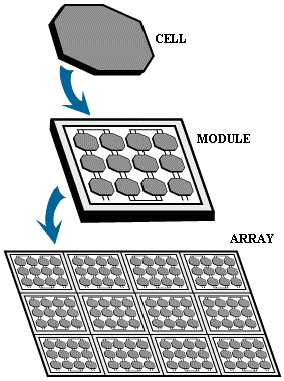| PHYSICS OF SOLAR CELLS |
How it Works
Most Solar cells convert light
energy into electrical energy through a process known as the
photovoltaic effect. The photovoltaic effect occurs when light
intercepts a two-layer semiconductor material, which produces a
potential difference (voltage) between the two layers. The voltage
produced is capable of creating a current through an external
electrical circuit, which can be stored or used to power electrical
devices.
Photovoltaic cells are made of semi-conductive material, typically
silicon, along with impurities added to certain layers. The simplest
solar cell has 3 active layers. The top junction layer, which has an
excess of electrons, is referred to as a n-type semiconductor.
The
bottom junction layer, which has a deficient amount of electrons, is
referred to as a p-type semiconductor. The middle layer between the
n-type and p-type is called the p-n junction, or absorber layer. Due to
the imbalance of electrons between the top and bottom layers, the p-n
junction has a built-in electric field.
Sunlight is composed of photons, which can be considered as "packet" of energy. The amount of energy in a photon is proportional to the frequency of its light. When photons hit the surface of a photovoltaic cell, it can either be reflected or absorbed. The photons that are absorbed penetrate into the n-type semiconductor. More specifically, into an electron in an atom in the cell. If enough energy is transferred from the photon, the electron can escape from its bond to the atom. In the process of an escaping electron, it leaves a hole where it originally came from. Due to the presence of an electric field in the p-n junction, the negatively charged electrons flow to the n-type side. While its positively charge hole is pulled to the p-type side. The freed electrons move through the semiconductor material searching for another hole to combine with and release their excess energy.
If we provide an external path for the electrons to flow, the electrons, driven by the electric field within the device, will flow through this path from the top layer. To unite with the holes the electric field had pulled towards the bottom layer. The potential difference between the layers of the device are capable of driving the current through the external circuit and thereby produce useful work.
An individual photovoltaic cell can produce small amounts of electrical energy. In order to produce a larger amount, multiple solar cells can be electrically connected to one another. Multiple solar cells are mounted in a support frame, which is called a photovoltaic module. Multiple modules can be connected together to form an array. The larger the area of an array, the more electricity it can produced. Arrays can be connected in either series or parallel configurations to produce any voltage and current combination.
Sunlight is composed of photons, which can be considered as "packet" of energy. The amount of energy in a photon is proportional to the frequency of its light. When photons hit the surface of a photovoltaic cell, it can either be reflected or absorbed. The photons that are absorbed penetrate into the n-type semiconductor. More specifically, into an electron in an atom in the cell. If enough energy is transferred from the photon, the electron can escape from its bond to the atom. In the process of an escaping electron, it leaves a hole where it originally came from. Due to the presence of an electric field in the p-n junction, the negatively charged electrons flow to the n-type side. While its positively charge hole is pulled to the p-type side. The freed electrons move through the semiconductor material searching for another hole to combine with and release their excess energy.
If we provide an external path for the electrons to flow, the electrons, driven by the electric field within the device, will flow through this path from the top layer. To unite with the holes the electric field had pulled towards the bottom layer. The potential difference between the layers of the device are capable of driving the current through the external circuit and thereby produce useful work.
An individual photovoltaic cell can produce small amounts of electrical energy. In order to produce a larger amount, multiple solar cells can be electrically connected to one another. Multiple solar cells are mounted in a support frame, which is called a photovoltaic module. Multiple modules can be connected together to form an array. The larger the area of an array, the more electricity it can produced. Arrays can be connected in either series or parallel configurations to produce any voltage and current combination.
|
Designed by Elliot Smith


